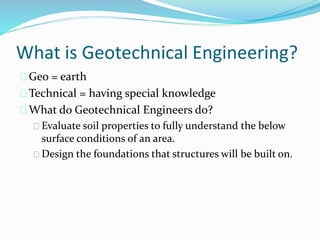Getting My Geotheta To Work
Getting My Geotheta To Work
Blog Article
10 Simple Techniques For Geotheta
Table of ContentsGeotheta Can Be Fun For AnyoneGetting My Geotheta To WorkThe Main Principles Of Geotheta The Ultimate Guide To Geotheta10 Easy Facts About Geotheta Shown

They carry out site examinations, gather examples, execute research laboratory tests, and assess data to review the suitability of the ground for building and construction jobs - Geo Tech Engineering. Based upon their searchings for, geotechnical designers supply recommendations for foundation layout, slope stability, maintaining structures, and mitigation of geotechnical threats. They team up with other professionals, such as architects, architectural designers, and building and construction teams, to guarantee that geotechnical factors to consider are incorporated into the overall project style and execution
By assessing the actions and properties of soil and rock, they can recognize prospective geotechnical threats such as landslides, soil settlement, or incline instability. Their expertise assists avoid failures or mishaps that might threaten lives and building. Right here are some in-depth tasks and responsibilities of a geotechnical designer: Site Investigation: Geotechnical engineers conduct website investigations to collect data on subsurface problems.
They analyze the information to understand the residential or commercial properties and habits of the soil and rock, including their strength, permeability, compaction features, and groundwater problems. Geotechnical Evaluation and Layout: Geotechnical engineers examine the data collected during website investigations to analyze the stability and viability of the site for building and construction projects. They do geotechnical computations and modeling to evaluate factors such as bearing capacity, negotiation, incline stability, side earth stress, and groundwater flow.
The Basic Principles Of Geotheta
Structure Style: Geotechnical engineers play an important role in designing foundations that can securely sustain the intended framework. They evaluate the soil conditions and tons requirements to establish the ideal structure type, such as shallow structures (e.g., grounds), deep structures (e.g (http://prsync.com/geotheta/)., piles), or specialized methods like dirt enhancement. They consider factors such as negotiation limits, birthing capacity, and soil-structure communication to develop ideal foundation designs
They assess building plans, monitor website activities, and perform field evaluations to confirm that the style recommendations are followed. If unanticipated geotechnical concerns occur, they analyze the situation and offer referrals for removal or adjustments to the layout. Risk Evaluation and Mitigation: Geotechnical engineers examine geotechnical risks and threats associated with the project website, such as landslides, liquefaction, or soil erosion.

Collaboration and Interaction: Geotechnical designers work very closely with various other experts involved in a job, such as architects, architectural designers, and building teams. Effective interaction and cooperation are vital to incorporate geotechnical considerations right into the overall task design and building and construction procedure. Geotechnical designers offer technical know-how, answer questions, and ensure that geotechnical requirements are satisfied.
Not known Facts About Geotheta
Here are some kinds of geotechnical designers: Foundation Engineer: Foundation engineers specialize in designing and evaluating structures for structures. They examine the dirt conditions, tons requirements, and site qualities to identify the most ideal structure type and layout, such as superficial structures, deep structures, or specialized strategies like heap structures.
They examine the aspects influencing slope security, such as dirt residential properties, groundwater problems, and incline geometry, and Click This Link develop methods to avoid incline failings and minimize risks. Earthquake Designer: Earthquake designers concentrate on analyzing and designing frameworks to hold up against seismic pressures. They assess the seismic danger of a site, review soil liquefaction possibility, and create seismic layout standards to make certain the security and strength of frameworks during quakes.
They execute field screening, gather examples, and evaluate the gathered information to characterize the dirt buildings, geologic formations, and groundwater problems at a site. Geotechnical Instrumentation Designer: Geotechnical instrumentation designers concentrate on tracking and measuring the actions of soil, rock, and structures. They set up and maintain instrumentation systems that check aspects such as dirt settlement, groundwater degrees, slope motions, and structural displacements to examine efficiency and give very early cautions of prospective issues.
7 Easy Facts About Geotheta Explained
They conduct examinations such as triaxial tests, debt consolidation examinations, straight shear tests, and leaks in the structure examinations to gather data for geotechnical evaluation and design. Geosynthetics Engineer: Geosynthetics engineers concentrate on the layout and application of geosynthetic materials, such as geotextiles, geogrids, and geomembranes. They make use of these materials to enhance dirt security, reinforce slopes, provide drainage services, and control erosion.
They have a tendency to be investigative individuals, which means they're intellectual, reflective, and inquisitive. They are interested, systematic, sensible, logical, and rational. Some of them are likewise social, implying they're kind, generous, cooperative, patient, caring, helpful, compassionate, tactful, and friendly. Does this noise like you? Take our complimentary career test to discover if geotechnical designer is among your top occupation matches.
In the office setting, geotechnical engineers use specialized software application devices to do computations, develop layouts, and analyze data. They prepare records, evaluation task specs, communicate with customers and group participants, and coordinate task tasks. The office setting provides a favorable setting for study, analysis, and collaboration with other experts associated with the job.
Getting The Geotheta To Work
They frequently visit project sites to perform site investigations, assess geotechnical problems, and collect information for evaluation. These brows through include traveling to different areas, sometimes in remote or tough surfaces. Geotechnical designers may execute soil sampling, conduct tests, and display building and construction tasks to make sure that the geotechnical elements of the job are being carried out correctly.
Geotechnical engineers additionally operate in specialized geotechnical research laboratories. In these facilities, they conduct experiments, execute examinations on soil and rock samples, and evaluate the engineering properties of the products. Geotechnical lab designers function extensively in these environments, handling screening equipment, operating instruments, and videotaping information. They collaborate with various other laboratory personnel to guarantee exact and trustworthy testing outcomes.
Report this page